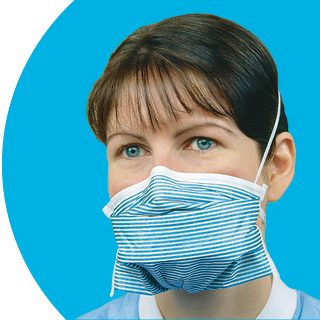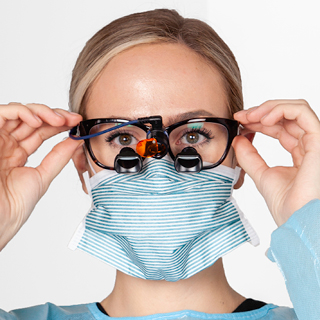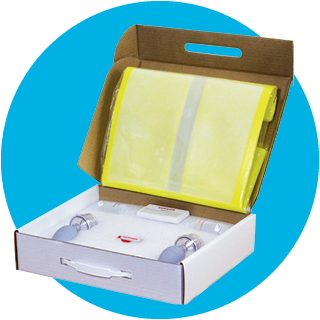Blog
Protection and Proper Fit with N95 Respirators

How to Test the Fit of N95 Respirators to Keep Yourself, Your Fellow Clinicians, and Your Patients Safe from Airborne Disease
In order to combat the ongoing COVID-19 pandemic, the interim guidance from the U.S. Centers for Disease Control and Prevention (CDC) requires the use of N95 respirators (or a higher level of protection) during all aerosol-generating dental procedures in areas where community transmission of COVID-19 is moderate to substantial. For dental healthcare professionals, this means that following proper protocols – and documenting your efforts – is critical.
N95 respirators have proven themselves to be extremely effective at reducing the risk of transmission of airborne infections like the coronavirus, as well as other infections transmitted via droplets. Indeed, the “95” in N95 refers to the respirator’s ability to filter at least 95% of airborne particles.
But an N95 respirator only works as well as the seal between the edges of the respirator and the wearer’s face.
No seal, less protection – which is why proper respirator fit is critical to protecting you, your colleagues, and your patients from infection.
In this article, we’ll explain how N95 respirators function, why they’re essential elements in your office’s safety protocols, what we mean by a “proper fit,” and how and when to test your respirators to ensure they fit each user correctly.
How Do N95 Respirators Work?
To understand why a proper fit is so crucial, it’s useful to know how N95 respirators protect their wearers. When a wearer inhales or exhales through an N95 respirator, particulate matter is captured in a layer of nonwoven material. Thanks to this filtration layer, N95 respirators can achieve high levels of both bacterial filtration efficiency and particulate filtration efficiency.
While all N95 respirators offer a high level of filtration efficiency, two types commonly used in healthcare settings – standard N95s and surgical N95s – serve slightly different functions. Surgical N95s offer higher levels of fluid resistance and should be used whenever possible during aerosol generating patient procedures.

Why Does Proper Fit Matter?
Unlike standard surgical masks, which are designed to fit loosely, N95 respirators are meant to be tight-fitting around the wearer’s mouth and nose. Any gaps will provide paths for microorganisms to leak into and out of the respirator.
If infectious particles are in the air, a poorly fitting N95 respirator will not offer optimal protection.
When Should N95 Respirators Be Worn?
The CDC stipulates that dental healthcare professionals should wear N95 respirators during aerosol-generating procedures, which can include the use of ultrasonic scalers, high-speed dental handpieces, and air/water syringes. (The CDC defines aerosols as “particles of respirable size, <10 μm.”)
It’s important to note that aerosol clouds can linger in the air for as long as 30 minutes after a procedure. Clinicians should continue to wear respiratory protection after finishing treatment and while they turn the room for the next patient.

What Does the CDC Say About Proper Fit and Fit Testing?
In the latest iteration of its interim guidance for dental settings, the CDC says, “Respirators should be used in the context of a comprehensive respiratory protection program, which includes medical evaluations, fit testing and training in accordance with the Occupational Safety and Health Administration’s (OSHA) Respiratory Protection standard.”
According to the CDC, a proper fit is snug against the user’s face, with no gaps between the skin and the respirator seal. The bottom strap should be securely placed at the base of the skull, below the earlobes, with the top strap secured around the crown towards the back of the head. The straps should not crisscross.
N95 respirators should not be worn with facial hair, jewellery, or anything else that can prevent proper placement.
What Is Fit Testing for an N95 Respirator?
There are two ways to test the fit of an N95 respirator: a qualitative method and a quantitative one. Ambulatory healthcare facilities – such as dental practices – typically use the qualitative approach.
A qualitative fit testing kit typically includes a hood or shroud that goes over the wearer’s head and covers the shoulders, isolating the breathing area. A clear plastic shield allows the wearer to see. Below the plastic shield is a vented opening connected to a portable nebulizer (a spray bottle).
Inside the nebulizer is a chemical solution designed to have an easily-detectable flavor or scent – usually something sweet or bitter. If the wearer does not detect the smell or taste, their respirator is fitting appropriately. Quantitative fit testing recommends a series of active movements to simulate clinical activity during testing.
While fit testing is critical, it’s also important to also conduct a user seal check each time a respirator is worn.
When Should Fit Testing Be Conducted?
Fit testing is required for every clinician for every type or brand of N95 respirator they plan to use. Following medical approval for safety of use, initial fit testing can be conducted.
Initial fit testing should be documented. Testing should be repeated anytime an individual loses significant weight, has facial surgery or extensive dental work, or experiences anything else that could alter their face’s structure. Although initial fit testing and medical evaluation is required, the FDA has provided state agency discretion in the enforcement of the annual testing requirement. However, it’s important to stay abreast of changing guidelines and, if N95 supplies allow, best practices would still call for annual fit testing.

Does Fit Testing Require Hiring a Specialist or Consultant?
High-quality N95 fit-testing kits come with instructions and everything your team should need to conduct tests that comply with CDC and OSHA guidelines. We recommend assigning a member of your staff, like the designated infection control/prevention coordinator, to familiarize themselves with the instructions, watch the appropriate training videos, and lead your practice’s testing efforts. While outside consultants are available to assist with fit testing, properly trained staff offer greater convenience and speed.
Will N95 Respirators Still Be Required When the COVID-19 Pandemic Is Over?
It’s difficult to predict how the COVID-19 pandemic will reshape dental infection prevention and control best practices. It’s likely that with increased awareness of the dangers of airborne infectious diseases, the use of N95 respirators will continue long after the pandemic recedes. N95 respirators reduce risk of transmission of the flu virus, the cold virus, and rhinovirus, as well as the coronavirus that causes COVID-19. They also reduce the transmission risk of other viruses, such as measles, mumps, and chicken pox.
(A similar change occurred after the AIDs crisis of the 1980s when most hygienists shifted permanently from bare fingers to wearing gloves.)
Therefore, fit testing kits are a wise investment that will find frequent use – keeping you and your patients safe, both during and after the current crisis.

